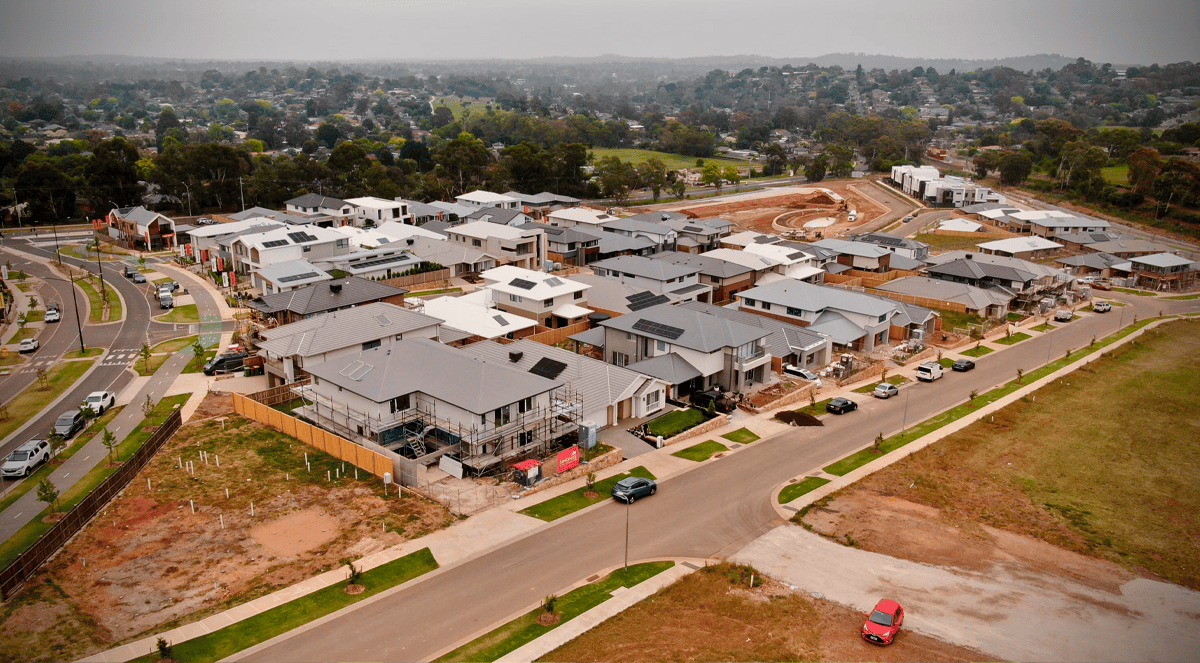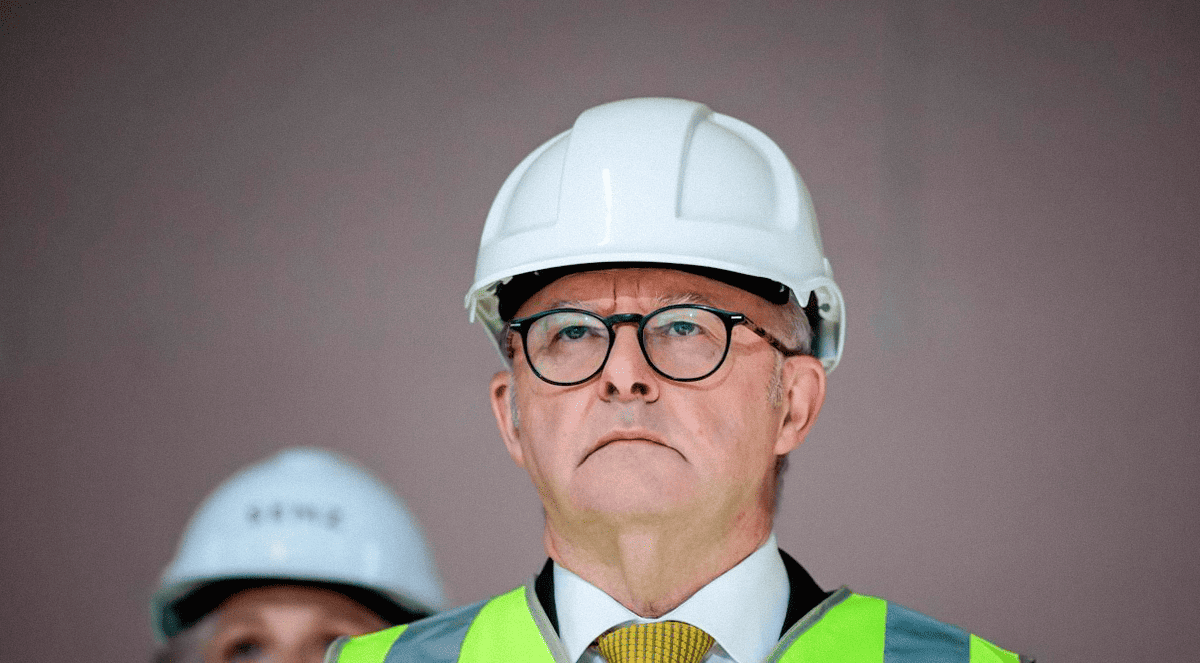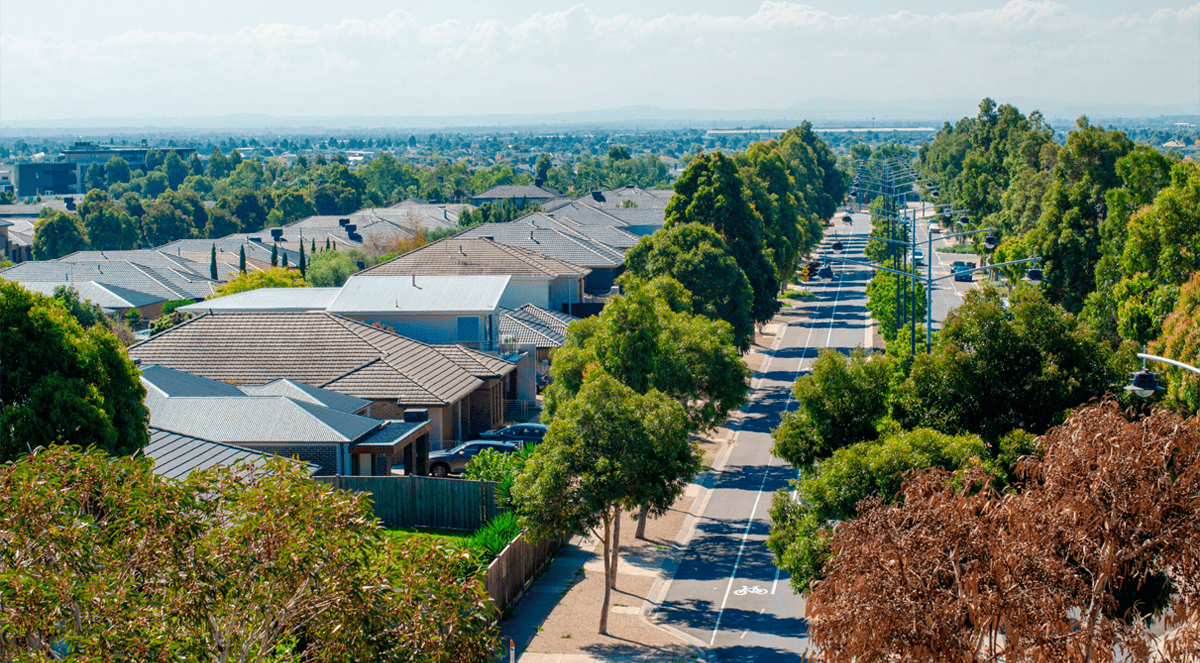Features > Property News & Insights > Market updates
New home lending stalls, signalling more trouble for housing supply

Image from ABC News/Peter Drought
KEY POINTS
- Loans for new builds, vacant land and construction in Australia fell 3.5% over the year to September 2025 and remain 38% below their 2021 peak
- Analysts say this trend is pushing more buyers toward established homes, creating more competition in the property market and driving prices higher
- Lending to investors has jumped by 9%, led by mortgages for properties in Victoria, and is now growing three times faster than owner-occupier lending
Australia’s home-loan market is shifting sharply away from new construction and land purchases, with fresh data showing lending for new builds has slumped to its lowest share in years.
Analysts say this trend is a tangible demonstration of the nation’s worsening housing shortage.
Money.com.au’s latest Mortgage Insights Report reveals a market dominated by refinancing, increasingly shaped by investors and with subdued lending for new builds.
The details
A deep dive into lending data from the Australian Bureau of Statistics shows Australians refinanced 618,966 loans in the year to September 2025, a four-year high.
537,326 new loans for properties were written.
It marks a dramatic reversal from 2021, when new loans outnumbered refinances by almost 100,000.
Internal refinancing is particularly strong, rising 29% year-on-year, almost double the growth in borrowers switching lenders.
Owner-occupiers still make up the bulk of refinancers, as households chase lower rates and restructure their debts in the wake of the RBA’s interest rate cuts.
But behind these headline figures sits a more troubling trend for Australia’s housing pipeline.
Loans for new builds, land and construction fell 3.5% in the year to September, totalling just 124,359, and remain 38.3% below their June 2021 peak.
Money.com.au Property Expert Debbie Hays says the data shows a market becoming narrower and more dependent on competition for existing homes.
“When borrowing for new builds continues to go backwards, it’s a clear sign that supply isn’t keeping up, and more buyers are being pushed to compete for existing properties.
“That inevitably drives prices higher, and with it, the average debt size,” she says.
The retreat from new-build lending is fuelling other distortions in the lending market.
The gap between average owner-occupier and investor loan sizes has nearly vanished.
Money.com.au’s Mortgage Insights Report says that difference is now just 0.3%, as both owner-occupiers and investors stretch their budgets further to secure established homes.
Investors surge back, led by Victoria
The report also confirms that investor activity has rebounded strongly, with investor loans up 9% in the year to September, reaching 205,533 loans.
That’s more than 32% above a lending trough in 2023.
Investor lending is also growing at three times the pace of loans to owner-occupiers.
Victoria, long viewed as an owner-occupier-heavy market, is now leading the country in investor loan growth, up 13% over the year.
Debbie Hays says the fundamentals have shifted.
“The fundamentals are still there in Victoria, including improved rental yields, stronger population growth and more attractive price points in Melbourne compared with Sydney, particularly across inner and middle-ring suburbs,” she says.
Queensland still has the largest share of the investor market at 23.4%, but Victoria is just behind on 23.2% and looks set to overtake the Sunshine State.
Double-digit investor loan growth was also recorded in NSW (11%) and South Australia (10%).
Owner-occupier demand recovering
Owner-occupier loan numbers rose 3% to 331,793 over the year, continuing a slow recovery but still reflecting a patchy national market.
Queensland remains the standout, up 5%, thanks to strong interstate migration and lifestyle demand.
More owner-occupied loans were issued for properties in the Sunshine State (72,475) than in Western Australia and South Australia combined.
Western Australia was the only major state to record a decline (down 2%).
While most market segments are expanding, first-home buyer loans fell 3% over the year - in sharp contrast to 8% growth among other buyer groups.
The period Money.com.au examined predates the expansion of the Federal government’s expanded First Home Guarantee, which took effect on 1st October 2025 and is widely expected to see a big uplift in first-home buyer loans.
Debbie Hays says the scheme will help first-home buyers, but only modestly.
“The expanded First Home Guarantee will give first-home buyers a lift, but only at the margins.”
“Deposit support helps, but it doesn’t solve the bigger issues of tight borrowing capacity, high prices and limited new supply,” she says.
First-home buyer loan sizes continue to rise at around 1.4% per quarter, while other buyers’ loan sizes have accelerated to 1.9% per quarter since mid-2024.
The takeout
Money.com.au’s Mortgage Insights Report paints a picture of a mortgage market increasingly reliant on refinancing, investor activity and competition for existing stock.
Meanwhile, lending for new builds, the lifeblood of housing supply, continues to retreat.
With Australia already falling short of national housing targets, the worrying decline in construction-related loans is a warning sign that the supply gap is set to widen further in the years ahead.
Stay Up to Date
with the Latest Australian Property News, Insights & Education.




.png?width=292&height=292&name=Copy%20Link%20(1).png)
 SIGN UP FOR FREE NEWSLETTER
SIGN UP FOR FREE NEWSLETTER





.jpg?width=1920&height=1080&name=Warning%2c%20You%20Might%20Be%20Facing%20Higher%20Taxes%20Soon%20(1).jpg)





.png?width=1920&height=1080&name=Rate%20Drops%20Signal%20BIGGEST%20Property%20Boom%20in%20DECADES%20(1).png)

.jpg?width=1920&height=1080&name=Labor%20vs%20Liberal%20These%20Housing%20Policies%20Could%20Change%20the%20Property%20Market%20Forever%20(1).jpg)
.jpg?width=1920&height=1080&name=QLD%20Slashes%20Stamp%20Duty%20Big%20News%20for%20Investors%20%26%20Home%20Buyers%20(1).jpg)
.jpg?width=1920&height=1080&name=Trump%20Just%20Slapped%20Tariffs%20%E2%80%93%20Here%E2%80%99s%20What%20It%20Means%20for%20Australia%20(1).jpg)
.jpg?width=1920&height=1080&name=Federal%20Budget%202025%20More%20Debt%2c%20No%20Housing%20%E2%80%93%20Here%E2%80%99s%20What%20You%20Need%20to%20Know%20(1).jpg)
.jpg?width=1920&height=1080&name=Australias%20Housing%20Crisis%20is%20about%20to%20get%20MUCH%20Worse%20(New%20Data%20Warns).jpg)
%20(1).jpg?width=1920&height=1080&name=Australias%20RENTAL%20CRISIS%20Hits%20ROCK%20BOTTOM!%20(2025%20Update)%20(1).jpg)
%20(1).png?width=1920&height=1080&name=Is%20Adelaide%20Still%20a%20Good%20Property%20Investment%20(2025%20UPDATE)%20(1).png)
.jpg?width=1920&height=1080&name=RBA%20Shocks%20with%20Rate%20Cuts!%20What%E2%80%99s%20Next%20for%20Property%20Investors%20(1).jpg)
%20(1).jpg?width=1920&height=1080&name=I%20Predict%20The%20Feb%20Rate%20Cut%20(My%20Price%20Growth%20Prediction)%20(1).jpg)
.png?width=1920&height=1080&name=Why%20Property%20Prices%20Will%20Rise%20in%202025%20Market%20Predictions%20(1).png)
.jpg?width=1920&height=1080&name=Why%20Investors%20Are%20Choosing%20Apartments%20Over%20Houses%202%20(1).jpg)
.jpg?width=1920&height=1080&name=Why%20Rate%20Cuts%20Will%20Trigger%20A%20Property%20Boom%20(1).jpg)
.jpg?width=1920&height=1080&name=Retire%20On%202Million%20With%20One%20Property%20(Using%20SMSF).jpg)
.jpg?width=1920&height=1080&name=4%20Reasons%20Why%20You%20Should%20Invest%20in%20Melbourne%20Now%20(1).jpg)
%20(1).jpg?width=1920&height=1080&name=Old%20Property%20vs%20New%20Property%20(Facts%20and%20Figures%20Revealed)%20(1).jpg)
%20(1).jpg?width=1920&height=1080&name=Will%20The%20New%20QLD%20Govt%20Create%20a%20Property%20Boom%20or%20Bust%20(My%20Prediction)%20(1).jpg)
%20Scott%20Kuru%20(1).jpg?width=1920&height=1080&name=Inflation%20Hits%20Three-Year%20Low%20(Will%20RBA%20Cut%20Rates%20Soon)%20Scott%20Kuru%20(1).jpg)
.jpg?width=1920&height=1080&name=How%20to%20Buy%20Investment%20Property%20Through%20SMSF_%20The%20Ultimate%20Guide%20(1).jpg)
.jpg?width=1920&height=1080&name=Victoria%20Slashes%20Stamp%20Duty%20Melbourne%20Set%20to%20Boom%20Scott%20Kuru%20(1).jpg)
.png?width=1571&height=861&name=Are%20Foreign%20Buyers%20Really%20Driving%20Up%20Australian%20Property%20Prices%20(1).png)
.jpg?width=1920&height=1080&name=The%20Single%20Factor%20That%20Predicts%20Property%20Growth%20Regions%20(1).jpg)
%20Scott%20Kuru%20(1).jpg?width=1920&height=1080&name=My%20Prediction%20On%20Rates%20%26%20Negative%20Gearing%20(Market%20Crash)%20Scott%20Kuru%20(1).jpg)

-1.png?width=1920&height=1080&name=Major%20Banks%20Cut%20Rates%20Will%20RBA%20Follow%20Suit%20(Sept%20Rate%20Update)-1.png)
%20Scott%20Kuru-1.png?width=1920&height=1080&name=Rate%20Cut%20Coming%20What%20New%20Zealands%20Move%20Means%20for%20Australia%20(Sept%20Prediction)%20Scott%20Kuru-1.png)
%20(1).jpg?width=1920&height=1080&name=Buy%20when%20the%20interest%20rates%20are%20high!%20(Why%20you%20must%20buy%20now!)%20(1).jpg)
.jpg?width=1920&height=1080&name=Carms_Revised%20Taxes%20Due%20Aug%209%20YT%20Thumbnail02%20(1).jpg)
.jpg?width=1920&height=1080&name=Carms_Too%20Little%20Too%20Late%20Aug%207%20YT%20Thumbnail01%20(1).jpg)









.jpg?width=1920&height=1080&name=Carms_Rate%20Drop%20In%20July%20Jun%2010%20YT%20Thumbnail02%20(1).jpg)
.jpg?width=1920&height=1080&name=Carms_Own%20a%20Property%20V6%20Jun%205_YT%20Thumbnail%20(1).jpg)









.png?width=1920&height=1080&name=Artboard%201%20(3).png)






.jpg?width=1920&height=1080&name=YT%20thumbnail%20%20(1).jpg)

